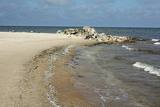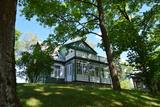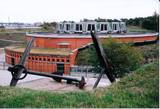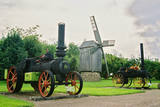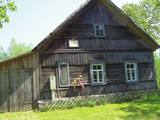| Nr | Nosaukums | Apraksts |
|---|---|---|
|
Kolkasraga galā ir redzamas viļņu noskalotās
vecās, 16. gs. celtās un vairākkārt pārbūvētās bākas drupas, kas pēc katras
lielākas vētras un aukstas ziemas (ledi!) paliek aizvien mazākas. Drupas
kādreiz atradušās krietnu gabalu sauszemē, tagad tās pamazām pazūd
zem ūdens.
|
||
|
Saimnieki ražo žāvētu garšaugu maisījumus un vitamīnu tējas pilnā ciklā – no sēklas līdz garšvielu paciņai. Saimniecības dobēs un siltumnīcās aug plašs dārzeņu un garšaugu klāsts - dilles, sīpoli, ķiploki, maurloki, piparmētras, salvija, timiāns, koriandrs, izops, estragons, pupumētra, čili, baziliks. Izmanto arī savvaļas augus - nātres, gārsas, vībotnes, pienenes, pelašķus, raudenes. |
||
|
Jau pēc dievnama veidola var spriest, ka vēl ne tik sen – padomju laikos ēka bija izmantota citām vajadzībām. Pēc 2. pasaules kara to atsavināja draudzei, bet torni – uzspridzināja, dievnamā ierīkojot noliktavu. 20. gs. deviņdesmitajos gados draudze uzsāka baznīcas atjaunotni un tagad tā kalpo savam pamatmērķim. |
||
|
Viesu nama viesistabā „Agluona” tiek gatavota kafija, var nogaršot arī citus Mazajai Lietuvai un Žemaitijai raksturīgos ēdienus. Tāpat tiek organizētas degustācijas. |
||
|
A. Baranauska un A. Vienoļa – Žukauska memoriālais muzejs izveidots 1927.gadā. Tajā tiek vāktas, glabātas un popularizētas muzeja vērtības, kas atspoguļo Anīkšču apkaimes kultūras, literatūras, vēstures, agrokultūras, tehniskās vēstures attīstību. Visas sezonas laikā apmeklētāji var pastaigāties pa Rakstnieku kalniņa memoriālo parku. |
||
|
Vecajā baznīcas skolā ierīkotajā Limandas ēdnīcā var nobaudīt garšīgus ēdienus. Gardo ēdienu gatavošanā ir izmantoti dabīgi un apkārtnes tīrumos audzēti dārzeņi. Zivju ēdieni ir gatavoti no vietējo zvejnieku piegādātajām zivīm. Blakus ēdnīcai atrodas rokdarbu veikals. |
||
|
Līdz mūsdienām gandrīz pilnībā ir saglabājies muižas apbūves komplekss (> 12 ēkas) un parks. Muižas pils celta 19. gs. 40. gados uz palielas ovālas salas, ko no visām pusēm ieslēdz grāvis. Šāds kungu mājas izvietojums imitēja viduslaiku nocietināto piļu paraugu. Kungu mājā šobrīd atrodas pagasta pārvalde, bibliotēka un pasts. Interesenti var doties izzinošā ekskursijā pa muižu un tās tuvējo apkārtni. Ar Veselavas muižu saistīti nostāsti par baronu un skaisto meitu – Kausuļu Rasu, kas līdzīgi Turaidas Rozei nepakļāvusies muižkunga iegribām. Lai dzirdētu šo stāstu pilnībā, ir jādodas uz Veselavu. |
||
|
Atrodas Amatas ielejas augstajā krastā, autoceļa (A 2) Rīga – Veclaicene malā. Plašs ēdienu klāsts, lielas porcijas, iecienīta tālbraucēju šoferu maltītes ieturēšanas vieta. |
||
|
Vēl pirms 20 - 30 gadiem Rojā dzīvoja Laimonis un Ilga Veidemaņi, kuri bija nedzirdīgi cilvēki un ar lielu mīlestību veidoja dažāda lieluma buru kuģu modeļus. Buru kuģu modeļu veidošanas pamatā bija neizsapņotais sapnis par lielajiem sentēvu kuģiem un plašajām jūrām, kuras nebūs lemts izkuģot. Buru kuģu modeļi tika darināti ar lielu precizitāti, rūpību un mīlestību, nekur nemācoties kuģu modeļu gatavošanas noslēpumus. Buru kuģu kolekciju tagad mantojusi Laimoņa Veidemaņa mazmeita, kura vēlas brīnišķīgo kolekciju un vectēva rūpīgo darbu parādīt plašākai publikai. Mājas saimniece apmeklētājus sagaidīs un pastāstīs savu stāstu par to, kā tapa kuģi. (Avots: Rojas TIC) |
||
|
Kopgalis atrodas Kuršu kāpu ziemeļdaļā iepretim Klaipēdas ostai. Te meklējami vairāki nozīmīgi un populāri Lietuvas un pat Baltijas mēroga tūrisma objekti. Kopgalis kopš seniem laikiem ir bijusi militāri un stratēģiski svarīga vieta, tādēļ 1866. g. prūšu militāristi šeit uzsāka vērienīga cietokšņa būvi, kura uzdevums bija Klaipēdas ostas aizsardzība. 2. pasaules kara laikā cietoksni uzspridzināja, bet 1979. g. uzsāka tā restaurāciju, izveidojot Baltijas valstīs vienīgo Jūras muzeju. Muzeja iespaidīgajā akvārijā ir apskatāmas Baltijas u.c. pasaules jūru un okeānu zivis, bet gar tā malām ir izvietota ekspozīcija. Apmeklētājus īpaši priecē graciozie dažādu sugu pingvīni un roņi to barošanas laikā. Vecajos Kopgaļa cietokšņa pulvera pagrabos ir izvietota Lietuvas kuģniecības tēmai veltīta ekspozīcija, bet uz bastioniem – seno ieroču kolekcija. Turpat atrodas Baltijas valstīs vienīgais Delfinārijs (no 1994. g.), kurš ir pazīstams ar delfīnu priekšnesumiem un reiterapijas kursiem. No Delfinārija gar Kuršu jomas krastu (lieliski Klaipēdas ostas skati!) var doties līdz Kuršu kāpu ziemeļu galam, kur atrodas mols – iecienīta makšķerēšanas vieta. Pretējā krastā ir redzama 1945. g. celtā 44 m augstā (pēc rekonstrukcijas 1953. g.) Klaipēdas bāka. Dienvidos no Jūras muzeja atrodas Kuršu kāpu nacionālā parka administrācija (Smiltynės gatve 11) un nacionālā parka apmeklētāju centrs, kurā apskatāms neliels Dabas muzejs. 100 m dienvidos no tā bijušā zvejniekciema vietā slejas etnogrāfiska zvejnieku sēta ar dzīvojamo un saimniecības ēkām, kā arī četrām oriģinālām zvejnieku laivām – no mazas zvejas laivas līdz pat lielajam kurēnam (burulaiva). Mazliet tālāk uz milzu podestiem ir novietoti trīs oriģinālie kuģi, ar kādiem jūrā zvejoja Padomju laikā. No Jūras muzeja ~ kilometru gara krasta promenāde aizved līdz Smiltīnei, kur kājāmgājēji un riteņbraucēji ar prāmi var pārcelties uz Klaipēdu. Autobraucējiem ir jādodas uz otru prāmi, kas atrodas 2 km dienvidos no Smiltīnes. |
||
|
Krodziņš atrodas ainaviskā vietā – Abavas senlejā starp Kandavu un Sabili. Izvietots vēsturiskā ēkā, kas būvēta 17. gs. un kur atradusies pārceltuve pār Abavu. Ēkā ir viens no lielākajiem Baltijas manteļskursteņiem. Blakus ūdenstūristu apmetne. Latviešu virtuve: Aukstā biešu zupa, frikadeļu zupa, skābeņu zupa, skābu kāpostu zupa, vistu akniņas, mājas kotlete, žāvētas cūkas ribiņas, cepta cūkgaļa, grilēta cūkgaļa, kartupeļu pankūkas ar krējumu, plānās pankūkas, dabīgās tējas. Īpašais ēdiens: Virtieņi pildīti ar kūpinātu gaļu, biezpienu un sīpoliem. |
||
|
Ilenurmes muižas kompleksā netālu no Tartu pilsētas ir iekārtots muzejs, kas lepojas ar savu lauksaimniecības tehnikas kolekciju un ekspozīciju “Lauksaimniecības un lauku dzīves attīstība Igaunijā cauri gadsimtiem”. To papildina dravniecības, zemnieku transporta līdzekļu, salmu un bērza tāšu izstrādājumu izstādes. Muzejs piedāvā izglītojošas programmas un kursus (kalēja darbi, koka izstrādājumu restaurēšana, klūdziņu pīšana un mēbeļu taisīšana, rudzu maizes cepšana, nacionālie rokdarbi utt.). Pēc iepriekšēja pasūtījuma grupām piedāvā nacionālos ēdienus. |
||
|
Ģimenei, bērniem un citiem interesentiem draudzīga vieta, kur var doties ekskursijā vai individuāli apskatīt un iepazīt murkšķus. |
||
|
Arbūzu audzēšanu saimnieki uzsāka 1997. g., izmantojot šķirnes, kas piemērotas Latvijas klimatiskajiem apstākļiem. Saimniecības „odziņa” ir arbūzi ar dzelteno mīkstumu. Lielākais izaudzētais arbūzs svēris 11 kg. Sezonas laikā – arbūzu iegāde un saimnieka padomi. |
||
|
200 m attālumā no Gulbenes – Madonas ceļa mežainā nogāzē iegūlis 2,4 m augstais akmens. Tā lēzenajā virsmā iekalta ap metru gara, 0,3 m plata un ap 4 cm dziļa iedobe, bet akmens šķautnē - pakāpieni. Uzskata, ka šis ir sens kultakmens, pie kura ziedots. Lai nokļūtu līdz akmenim, vasaras otrajā pusē var nākties brist pa garu zāli. |
||
|
Amata ir viena no straujākajām Latvijas upēm, tādēļ pavasaros šeit pulcējas ūdenstūristi – sportisku aktivitāšu un asu izjūtu cienītāji! Lejpus Rīgas-Veclaicenes autoceļa Amata ieplūst dziļā ielejā, kur upes vidējais kritums pārsniedz 3 m/km, lejtecē sasniedzot pat 8 - 10 m/km. Ūdenstūristi parasti izmanto upes posmu no Melturiem līdz Zvārtes iezim vai Līgatnes–Kārļu ceļa tiltam (Veclauču tilts). Taču jāatceras, ka Amata nav domāta iesācējiem! Pēc ilgstošām lietavām upe var būt braucama arī citos gadalaikos. Amatas ieleja ir pievilcīga ar saviem iespaidīgajiem smilšakmens un dolomīta atsegumiem, sauktiem par iežiem, no kuriem zināmākie ir Vizuļu iezis (te var veidoties skaists leduskritums), Ainavu krauja, Ķaubju iezis, Dzilnas iezis, Zvārtes iezis un Lustūzis. No Melturiem līdz Veclaužu tiltam gar upes labo krastu ir nomarķēta (oranži punkti uz koku stumbriem) t.s. Amatas ģeoloģiskā taka. Takai ir trīs posmi: Melturi – Kārļu zivjaudzētava, Kārļu zivjaudzētava – Zvārtes iezis (abi posmi var būt ekstrēmi!) un Zvārtes iezis – Veclauču tilts. Pārgājienu var veikt jebkurā laikā, izņemot dziļā sniegā. Iespaidīgākie skati būs vērojami bezlapu laikā. Tiesa, braucot ar laivu, atsegumu vērošanai un fotografēšanai nesanāks laiks, jo būs jākoncentrējas uz šķēršļiem upē. |
||
|
Rakstnieka Mihaila Naricas māja – muzejs. Četrreiz represēta
rakstnieka, mākslinieka mājā – muzejā var iepazīties ar politisko represiju
vēsturi PSRS un Padomju Latvijā, kā arī ar M. Naricas izglītojošā
centra organizēto daiļrades konkursu laureātu darbiem.
Darba laiks: pēc pieteikuma |
||
|
Krimuldas pili cēla 13. gs. otrajā pusē. Tā ir vieta, kur Gaujas senlejas labo pamatkrastu pāršķeļ dziļā Vikmestes grava. Pils (saimniekoja Rīgas domkapituls – Rīgas arhibīskapu padome) bija iespaidīga celtne, kuras plašo iekšpagalmu ietvēra 1,5 m biezs aizsargmūris. 1601. g. atkāpjoties, Krimuldas pili uzspridzināja zviedru karavadonis Heinrihs Līvens. Tagad ar mežu apaugušajā pilskalnā apskatāms neliels pils mūra fragments. Pie Krimuldas pilsdrupām ir meklējams Siguldas Gaisa tramvajs un sākas Krimuldas Serpentīna ceļš – vienīgais šāda veida objekts Baltijas valstīs. |
||
|
Ļoti ainavisks ezers, uz kuru paveras lieliskas ainas no Vidzemes augstienes pauguriem. Te jāatceras latviešu teika par Ineša un Alauksta strīdu, kā rezultātā Inesis dabūja pliķus – salas, kurām (sešām) tāpat kā Sproģu pussalai ir dabas lieguma statuss. |
||
|
Stelmužes muižas parks izveidots 18.gs. vidū uz dienvidiem no Stelmužes ezera. No visām pusēm uz pakalna esošo Jēzus tā Kunga krusta baznīcu ved līkumotas takas, augu valstī dominē liepas, kļavas, ozoli, gobas, bērzi, egles, oši, priedes. Stelmužes muižas parka pakalna pakājē atrodams Laimes avots, var pastaigāt pa ozolu aleju. Stelmužes ozols – vecākais un resnākais Lietuvā augošais ozols ir viens no senākajiem ozoliem Eiropā. Lēš, ka tā vecums ir ap 1500 – 2000 gadiem, tā diametrs ir rekordliels – 3,5 m (lai stumbru apņemtu, vajag 8 – 9 vīrus), augstums 23 m. |
||
